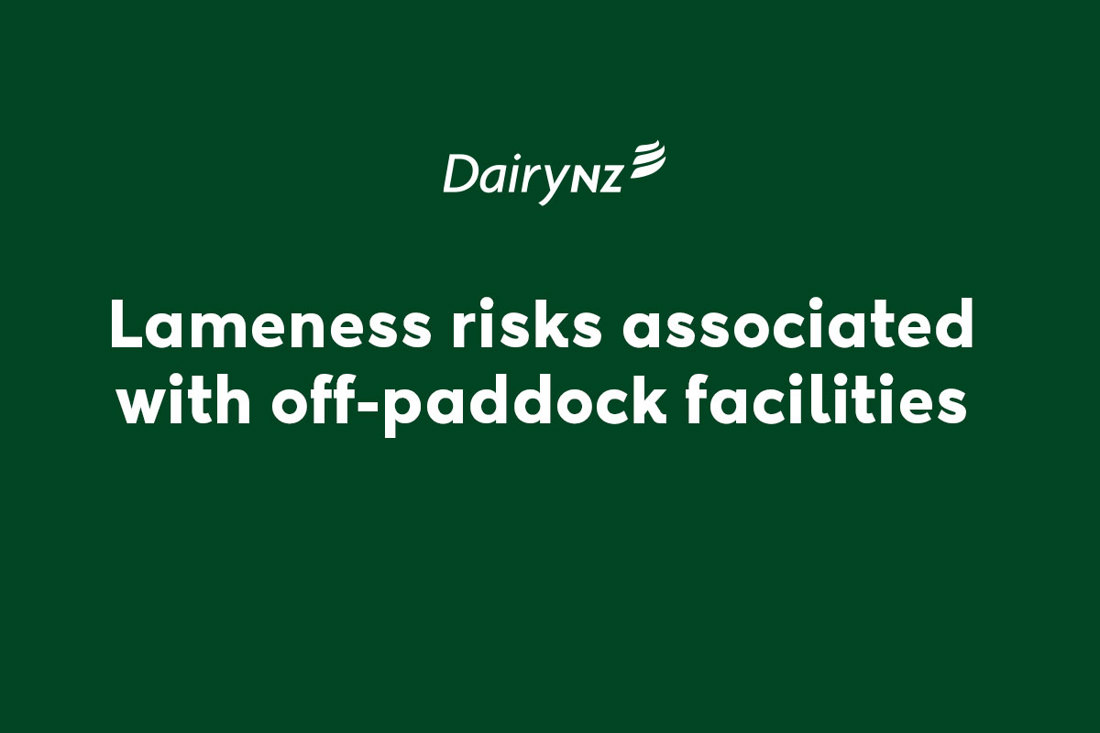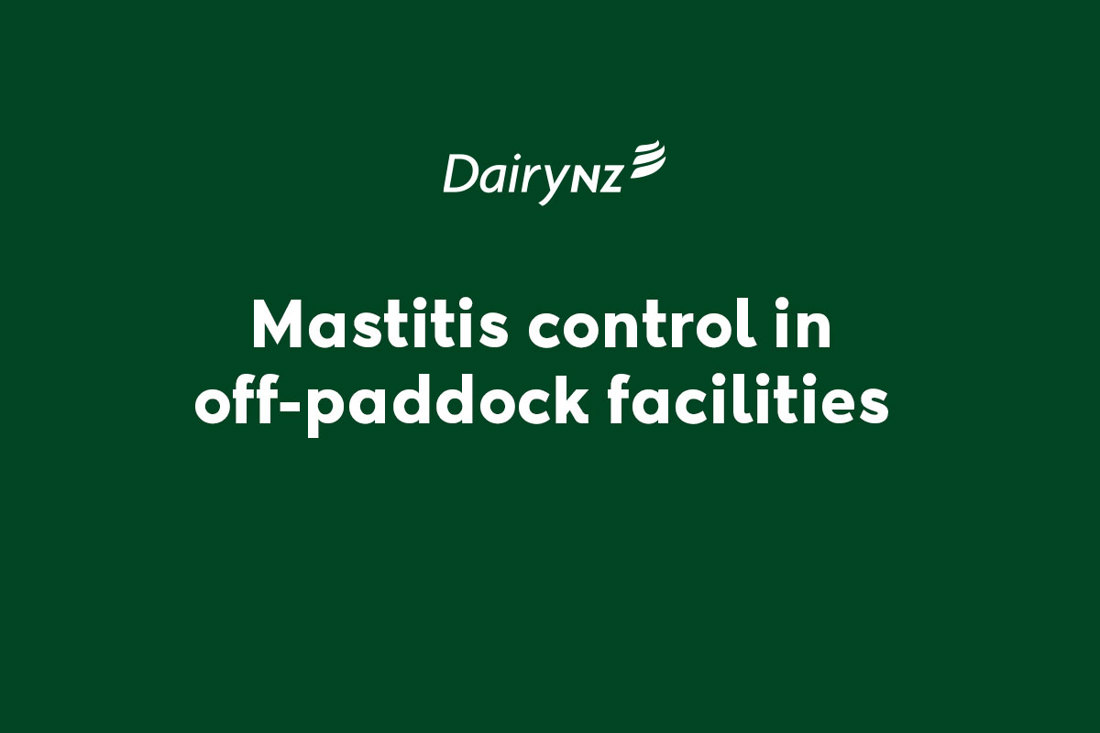Managing off-paddock facilities
5 min read
Effectively managing your off-paddock facilities with good practice principles is key to ensuring cow comfort and optimal performance. Managing cows in an off-paddock facility requires a different set of skills compared to pasture-based management. Priorities will vary depending on the farm system, the length of time cows spend indoors, and the type of housing used, making it important to tailor management practices to suit both the cows’ needs and the facility.
When cows spend extended time in off-paddock facilities, their hooves are exposed to increased wear and softening, which increases the risk of lameness, injury, and infection. Standing on hard surfaces, particularly concrete, can contribute to hoof damage, while prolonged exposure to wet conditions softens hooves, making them more vulnerable to issues.
If cows are housed on concrete for long periods, it is important to monitor them regularly for signs of lameness, overgrown hooves, and hock lesions.
Slippery surfaces pose a risk, especially if cows trip or fall due to heat-related behaviour or poor footing. Scraper systems can leave behind effluent that becomes sticky and slippery in warm conditions or when cows are on a high dry matter diet, increasing the chance of injury.
Standing on concrete for extended periods can lead to excessive sole wear. It can take up to 12 weeks for cows’ hooves to adjust by increasing hoof growth, but during this transition, thin soles and physical lameness may develop. In some cases, cows can also over-adapt, leading to overgrown hooves.
Do routine observation for lameness, particularly in the first three months of transitioning cows into an off-paddock facility.
Not every cow will adapt to housing. More frequent monitoring will help detect early issues, and after this period, ongoing checks should focus on preventing overgrown hooves, especially in cows spending most of their time in the facility.

Environmental mastitis is often caused by prolonged exposure to dairy effluent, and off-paddock facilities may increase this risk if not managed. Cows' teats are more likely to be contaminated by mastitis-causing bacteria in these environments, which can impact herd health and milk quality.
Good management is key to reducing this risk. Keeping the facility and cows clean, by maintaining dry, well-managed bedding and minimising contact with effluent, water, or milk residues, can help prevent environmental mastitis. The video highlights key risk indicators in off-paddock facilities, including bedding management and teat health between milkings.

Managing effluent from off paddock facilities requires a system for capturing, storing, and applying solid and liquid effluent as part of the whole-farm nutrient management plan.
Additional costs may be involved depending on the type of infrastructure selected. Careful planning is needed to ensure compliance with district and regional council regulations, particularly regarding effluent application timing, paddock selection for solids, odour management, and nutrient budgets.
Existing effluent systems from the farm dairy may be able to handle effluent from the off-paddock facility, but only if there is sufficient storage capacity and enough land area available for safe application. The composition of the effluent may change due to different feed sources, requiring careful management of both solid and liquid (green waste) effluent. Alternatively, a stand-alone effluent system may be required to manage the additional volume from an off-paddock facility. When designing this, it is essential to include Dairy Effluent Storage Calculations (DESC), factoring the intended period of use. Seek advice from a consultant to ensure your system meets farm needs and regulatory requirements.
Investing in off-paddock infrastructure often means bringing in more supplementary feeds, which increases nutrient loads on the farm. To prevent imbalances and environmental risks, it is critical to redo the farm nutrient budget to account for the extra nutrients from manure. This will help optimise nutrient use, improve pasture and crop management, and ensure compliance with farm environment plans.
Dairy effluent is naturally high in potassium (K), which can accumulate in pasture if not managed correctly. Excess K uptake by plants can lead to high K levels in leaves When cows eat these leaves their mineral balance may be disrupted and contribute to metabolic diseases related to magnesium or calcium deficiencies. To protect cow health, effluent application timing and rates should be based on soil and woodchip test data, ensuring nutrient levels remain balanced and safe for grazing.

Tim Campbell, a Rural Infrastructure consultant, shares his top tips for effluent design.
Keeping cows clean is essential for their comfort, health, and reducing the risk of infections such as mastitis. Cows lying in wet dung are more prone to discomfort and disease, making regular cleaning of passageways and crossovers a priority to prevent effluent buildup. Scrapers should run frequently, and scraper blades must be checked and replaced if worn to maintain effectiveness. Water from tipping troughs can also improve hygiene when integrated into cleaning routines.
Cultivate woodchip bedding daily with a rototiller, increasing to twice daily during periods of heavy use. Top up straw bedding daily to keep the surface clean and remove the top 30mm before it becomes overly saturated with moisture and manure.
A simple test to check the bedding, is to kneel on it for 10 seconds - if your knees stay dry, the bedding is well-managed.
Keep concrete areas clean to prevent cows from dirtying their legs, which can increase the risk of infections. Ensure proper drainage and regularly clean the yards and exit races, particularly in wet weather. Monitor cows for signs of nutritional or health-related scours, and if needed, consult a vet for management advice. Additionally, dry cows should receive appropriate intramammary protection (i.e. teat sealant) to help reduce the risk of mastitis before calving.
Nutrients in used bedding are a valuable resource that, when applied to land, can reduce fertiliser costs and increase pasture production.
The Pastoral 21 research programme measured the nutrient values and rates of nitrogen (N) released from freshly collected and composted bedding material. The material was recovered from a covered wintering shelter with a woodchip floor.
Woodchip covers several products including post peelings, log chips and bark. It varies in size and source (green or recycled wood from various types of trees). Used woodchip bedding is a mixture of woodchip and effluent.
The Pastoral 21 research found that each wet tonne of material contained:
Used bedding is high in carbon (due to the wood component). A high C:N ratio indicates that most of the N is locked up and not readily available to plants.
Ensure storage and composting of used barn bedding follows regional council requirements. This will require a hard surface and the ability to capture any run-off liquid.
The Pastoral 21 trial recovered 287 tonnes of used bedding which was applied to pasture at low rates of 20m3/ha, once a year. This did not choke grass or interfere with subsequent silage harvesting. However, 20m3/ha did not use much of the total volume of used bedding e.g. a 200-hectare milking platform would only use 4 tonnes of used bedding. Avoid spreading on calving paddocks because excess K increases the risk of metabolic disease around calving.
Incorporating woodchip into land before sowing crops or grass allows higher application rates. You can use bedding straight from the shelter or pad (without composting), but the N will not be available until the bedding rots, and it may lock up soil nitrogen requiring additional fertiliser N in the early stages of crop/pasture growth.
Most farmers are choosing to compost woodchip for 12 months on a sealed pad before incorporating it into the soil as this increases the availability of the woodchip N. Woodchip composting can be done in several ways but simply leaving it on a sealed surface works well for some farmers. If you plan to compost waste woodchip, check your regional council requirements for capturing run-off.
Woodchip products are highly variable, so request a Calcium to Nitrogen (C:N) ratio test and compost analysis on used woodchip. A Calcium to Nitrogen ratio of less than 15:1 is best for N availability. During composting, some N will be lost to air so get a C: N ratio test before using it.
Now’s the perfect time to check in, plan, and set up for a strong season. We’ve pulled together smart tips and tools to help you stay ahead all winter long.
Whether you prefer to read, listen, or download handy guides, we’ve got you covered with trusted tools to support your journey every step of the way.
Put our proven strategies and seasonal tools to work. Boost production, support animal health and watch your profits hum.
Tools that are backed by science, shaped by farmers and made for this season.
That’s Summer Smarts.